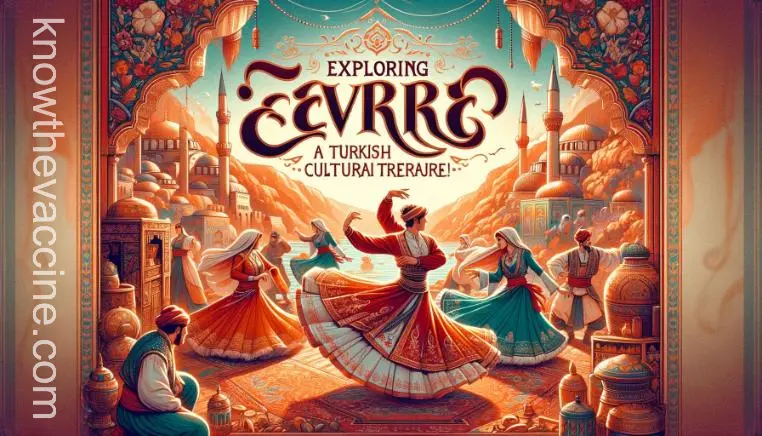
Evırı is a traditional Turkish dance form that originated in Central Anatolia in the 14th century. In this blog post, we will delve deeper into this captivating dance’s history, culture, and significance.
What is Evırı?
Evırı is a captivating form of Turkish cultural expression with deep roots stretching back centuries. This rhythmic dance is a celebration of unity, encapsulating the diverse spirit of the Anatolian people. As both a tradition and an art form, evırı offers valuable insights into Turkish heritage and identity.
The Roots of Evırı
Evırı has deeply rooted origins stemming from nomadic tribes that inhabited Anatolia in ancient times. These tribes utilized dance as a means of celebrating important events, expressing themselves artistically, and building a sense of unity. Over centuries, their dance forms evolved into distinct regional styles that mirrored the unique characteristics of each local culture and environment.
Originating in Central Anatolia
Specifically, the origins of Evırı can be traced back to the tribal communities of Central Anatolia in the 14th century. These nomadic groups gradually settled into agricultural villages, yet maintained their traditional dance practices that became ingrained aspects of cultural expression. Evırı originated as one of these dances, one which captured the spirit and rhythms of daily life for the people of Central Anatolia.
Cultural Significance of Evırı
Beyond its artistic merit, Evırı came to represent much more for the Turkish people. It served as a thread of cultural identity, especially as various empires rose and fell throughout Anatolia over subsequent centuries. The dance mirrored the heritage and traditions that united diverse populations across the Mediterranean region under a shared cultural realm.
A Reflection of History
The iterations and regional variations of Evırı that emerged over time also reflected important historical periods and influences. For instance, certain dance expressions incorporated elements from neighboring Greek, Arabic, and Persian cultures during their reign over Anatolia. In this way, Evırı came to encapsulate the rich cultural diversity and interactions that have defined the region through the centuries.
Evırı continues to resonate strongly as a symbol of Turkish cultural roots and a connection to ancestral origins. It stands as a captivating representation of where the Turkish people have come from and their persevering cultural traditions that transcend the test of time.
Cultural Significance Today
In the modern era, Evırı maintains profound cultural significance for Turks worldwide. It is frequently performed at celebrations, festivals, and other social gatherings as a means of honoring cultural heritage and bringing people together through shared traditions.
Beyond Turkey, various organizations founded by diaspora communities promote the preservation and performance of Evırı as a way of keeping their cultural identities alive across borders.
Honoring Tradition
Within Turkey itself, Evırı performances are common at folk art fairs, cultural exhibits, and public demonstrations organized to honor ancestral dance and musical styles. Younger generations learn regional variants of Evırı through community workshops and school programs aimed at sustaining cultural preservation.
In this way, Evırı plays a vital role in allowing Turks to celebrate their common cultural roots despite changing times. It serves as a reminder of ancient nomadic influences and helps newer communities worldwide maintain a sense of cultural continuity across eras.
Contemporary Variations
While honoring tradition, contemporary artists also impart new life into Evırı through creative reinventions. Fusion dance troupes and musician collectives incorporate elements of Evırı into their performances alongside influences from global pop and other styles.
Major cities have seen the emergence of innovative Evırı dance companies blending classic and modern styles. Young choreographers develop fresh interpretations reflecting their own regional identities and spiritual visions. In this dynamic artistic exchange, Evırı’s timeless expressions take on renewed cultural significance for evolving populations.
Steps and Techniques
While seeming improvisational, evırı follows particular steps and techniques:
- The dance occurs in an open circle formation with dancers side-by-side, led by a turning dancer in the middle.
- Participants hold shoulders or pinky fingers with hands down during rotation. The grip provides stability as dancers revolve around the center.
- Basic steps involve hopping or skipping while spinning rhythmically. More advanced dancers incorporate kneeling and spinning moves.
- Turning is done through the waist and hips with heads tilting sideways. The upper body stays upright while the lower body rotates.
- Arm movements include the waving of props like handkerchiefs. Arms raise on hops then lower while spinning.
- The tempo begins slowly and then gradually accelerates over time, driving the momentum of the dance.
- Facial expressions are joyful as dancers smile, exclaim, and sing along. Improvisation creates a playful atmosphere.
- Interactions occur between the central dancer and others through eye contact, singing, or playful exchanges.
Mastering these foundational techniques allows dancers to develop more advanced variations. However, evırı remains welcoming to beginners joining hands within the community circle.
Connecting to Evırı Today
For those interested in connecting more directly with this rich cultural tradition, Turkey offers abundant opportunities. Towns and villages throughout Central Anatolia regularly host public performances, especially during summer festivals. Larger cities like Ankara and Istanbul feature organized folk dance troupes.
Traveling to the picturesque towns and villages where Evırı was born allows one to truly experience its cultural context. Plus, local workshops offer hands-on lessons in regional dance styles directly from master instructors. Exploring Anatolia’s cultural treasures enhances appreciation for Evırı’s deep roots and evolving role in Turkish heritage.
Learning and Performing Evırı
For those interested in learning evırı, classes and performances provide interactive opportunities. Entering the dance circle creates a welcoming sense of belonging to a broader community.
Instruction often begins by learning basic steps and handholds. Repetition helps ingrain the body rotation and skipping motions central to evırı. Traditional music adds the rhythmic spirit, while costumes enhance immersion.
As dancers progress, more advanced techniques arise based on regional variations. For instance, kneeling and leaning back while spinning demonstrates skill. Syrian-style evırı includes colorful sticks struck together during the dance.
Performance settings allow shared celebration of Turkish dance and music. From festivals to weddings, these lively gatherings allow full cultural appreciation. For dedicated dancers, joining a dance troupe or competing allows further mastery and showmanship.
Turkish cultural centers worldwide offer evırı instruction both in-person and online. Traveling to Turkey provides exposure to skilled dancers and festivals. Immersing oneself in the sounds, sights, and energy of evırı allows deeply experiential learning.
Conclusion
Evırı dance embodies a profound cultural legacy that has survived centuries of transformation in Anatolia. It remains globally renowned as a timeless art form uniquely representing the Turkish people’s history, spirituality, and collective identity.
Both honoring tradition and imparting contemporary reinventions, it ensures Anatolia’s rich cultural expressions continue evolving for future generations. Its rhythmic beauty and captivating cultural significance make exploration of this traditional dance well worth the journey into Turkey’s vibrant cultural past and present.






